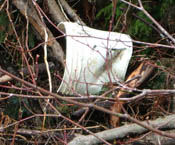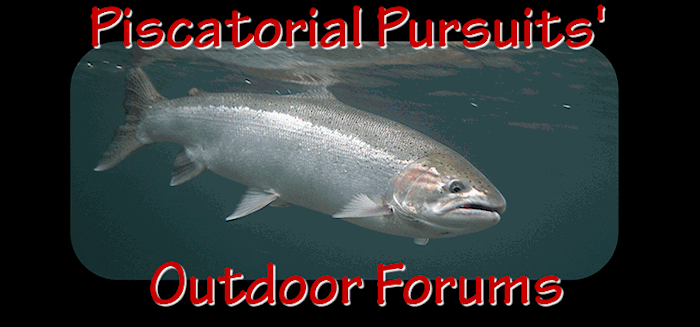#36392 - 12/03/06 12:55 AM
 Re: Sad day for the Kenai. . .
Re: Sad day for the Kenai. . .
|

Kitsap's Crankiest Contractor

Registered: 11/24/03
Posts: 2268
Loc: Poulsbo
|
Doc,
I don't know the numbers but I think the E-Tec passes the test.
_________________________
Have you ever listened to someone for a while and wondered..."who ties your shoelaces for you?"
|
|
Top
|
|
|
|
#36393 - 12/03/06 01:02 AM
 Re: Sad day for the Kenai. . .
Re: Sad day for the Kenai. . .
|

Ornamental Rice Bowl

Registered: 11/24/03
Posts: 12621
|
The newer precision-timed direct injection 2 strokes perform similar to 4 strokes in terms of unburned emissions.
The study I cited refers to older traditional run-of-the-mill 2 strokes that are accounting for the lion's share of pollution on the Kenai.
_________________________
"Let every angler who loves to fish think what it would mean to him to find the fish were gone." (Zane Grey) "If you don't kill them, they will spawn." (Carcassman)  The Keen Eye MD The Keen Eye MDLong Live the Kings!
|
|
Top
|
|
|
|
#36394 - 12/03/06 10:08 AM
 Re: Sad day for the Kenai. . .
Re: Sad day for the Kenai. . .
|

Juvenile at Sea

Registered: 07/27/05
Posts: 116
Loc: Soldotna, Alaska
|
Regardless of who's right in the "How much gas does a 2-stroke gas" quibble, anyone who thinks getting rid of the 2-strokes will make the problem go away is passing gas.
Does anyone actually think that use of the Kenai is likely to decline in the years ahead? Not a chance. Now there's no question the inefficient 2-strokes need to go, and to the degree they're eliminated over time, their contribution to hydrocarbon pollution will disappear.
On the other hand, if at the same time the horsepower limit is raised to 50, more hydrocarbons will enter the river. To claim that increased horsepower will not increase hydrocarbons is Brave New World Newspeak — "More is Less."
Add to that increased use of the Kenai by out-of-area Alaskans with now-legal 50-horsepower motors, increased area population, and increased commercial use, and we're not back where we started — we're much worse off.
Now the Feds are at the door. This pollution thing is not going to go away, and anyone who thinks getting rid of the 2-strokes solves the problems is greatly mistaken. Going to 50-horsepower is a bad, bad idea with ominous implications for the future. The 2-stroke solution is at best a very short term reprieve from a problem that's only going to get worse in the long term.
Alaskans have been here before, but are we any smarter? Alaskans could not resolve the rural preference issue because politics kept the question from being presented to the Alaskan people. Uncle Ted held the Feds off for a while, but in the end the Feds won, and Alaskans lost control of their resources.
Same thing obtains right now. Politics and special interests are pushing for a superficial, short-term fix by getting rid of old 2-strokes and raising the horsepower to 50. It won't work. The river will only become more polluted by bigger motors, increased use, and increased area development. Then one day the Feds will say, "Enough," and Alaskans will lose control of the Kenai. Special interests couldn't thumb their noses at ANILCA and special interests can't thumb their noses at the EPA and the Clean Water Act.
On the social level, getting rid of the 2-strokes, mostly mom-and-pop motors in one year rather than over a period of three or four years really puts the screws to folks who might not be able to shell out the bucks for a new engine. Simultaneously raising horsepower to 50, mostly if not exclusively, to benefit commercial users will only intensify the hostility felt by many toward that industry. Really bad press.
What needs be done is to get rid of the 2-strokes over time—gone by, say, 2010, keep horsepower limits where they are, and search for solutions that decrease current use patterns—smaller boats, fewer trips, lighter loads, etc. We simply can't continue to encourage a growth industry on and to the detriment of a finite resource.
Moeover to think that increased boat speeds will produce a safer fishery is, I thnk, wishful thinking that may come back to bite us. Surely a superficial examination of highway safety records will show that any increase in highway speed results in a proportionate increase in accidents. Can we honestly expect anything different from faster boats?
Habitat is being degraded by motorized angling activity and more. Using bigger motors may or may not slow down erosion, but how commendable is it to merely slow down abusive activity when to the degree than non-motorized use is increased, to that exact degree the habitat degradation caused by motors is entirely eliminated? Pandering to motorized use of the river is a pitiful substitute for doing the right thing, which is to reduce such activity.
Finally, many people are appalled at what they witness on the Kenai, viewing wholesale catch-and-release, combat fishing, and trophy hunting as an angling and social disgrace. Rather than attempting to continue to commercialize and develop an increasingly fragile Kenai River fishery, we should instead take a longer-term view, endeavoring instead to capitalize on the quality of the experience rather than sheer quantity.
Alaska Department of Natural Resources is receiving public comment on this issue until December 19th. Contact:
Chris Degernes
Chief of Field Operations
Division of Parks and Outdoor Recreation
550 W. Seventh Avenue, Suite 1380
Anchorage, AK 99501-3561
Fax 907-269-8907
E-mail Chris_Degernes@dnr.state.ak.us
|
|
Top
|
|
|
|
#36395 - 12/03/06 10:09 AM
 Re: Sad day for the Kenai. . .
Re: Sad day for the Kenai. . .
|

Juvenile at Sea

Registered: 07/27/05
Posts: 116
Loc: Soldotna, Alaska
|
Regardless of who's right in the "How much gas does a 2-stroke gas" quibble, anyone who thinks getting rid of the 2-strokes will make the problem go away is passing gas.
Does anyone actually think that use of the Kenai is likely to decline in the years ahead? Not a chance. Now there's no question the inefficient 2-strokes need to go, and to the degree they're eliminated over time, their contribution to hydrocarbon pollution will disappear.
On the other hand, if at the same time the horsepower limit is raised to 50, more hydrocarbons will enter the river. To claim that increased horsepower will not increase hydrocarbons is Brave New World Newspeak — "More is Less."
Add to that increased use of the Kenai by out-of-area Alaskans with now-legal 50-horsepower motors, increased area population, and increased commercial use, and we're not back where we started — we're much worse off.
Now the Feds are at the door. This pollution thing is not going to go away, and anyone who thinks getting rid of the 2-strokes solves the problems is greatly mistaken. Going to 50-horsepower is a bad, bad idea with ominous implications for the future. The 2-stroke solution is at best a very short term reprieve from a problem that's only going to get worse in the long term.
Alaskans have been here before, but are we any smarter? Alaskans could not resolve the rural preference issue because politics kept the question from being presented to the Alaskan people. Uncle Ted held the Feds off for a while, but in the end the Feds won, and Alaskans lost control of their resources.
Same thing obtains right now. Politics and special interests are pushing for a superficial, short-term fix by getting rid of old 2-strokes and raising the horsepower to 50. It won't work. The river will only become more polluted by bigger motors, increased use, and increased area development. Then one day the Feds will say, "Enough," and Alaskans will lose control of the Kenai. Special interests couldn't thumb their noses at ANILCA and special interests can't thumb their noses at the EPA and the Clean Water Act.
On the social level, getting rid of the 2-strokes, mostly mom-and-pop motors in one year rather than over a period of three or four years really puts the screws to folks who might not be able to shell out the bucks for a new engine. Simultaneously raising horsepower to 50, mostly if not exclusively, to benefit commercial users will only intensify the hostility felt by many toward that industry. Really bad press.
What needs be done is to get rid of the 2-strokes over time—gone by, say, 2010, keep horsepower limits where they are, and search for solutions that decrease current use patterns—smaller boats, fewer trips, lighter loads, etc. We simply can't continue to encourage a growth industry on and to the detriment of a finite resource.
Moeover to think that increased boat speeds will produce a safer fishery is, I thnk, wishful thinking that may come back to bite us. Surely a superficial examination of highway safety records will show that any increase in highway speed results in a proportionate increase in accidents. Can we honestly expect anything different from faster boats?
Habitat is being degraded by motorized angling activity and more. Using bigger motors may or may not slow down erosion, but how commendable is it to merely slow down abusive activity when to the degree than non-motorized use is increased, to that exact degree the habitat degradation caused by motors is entirely eliminated? Pandering to motorized use of the river is a pitiful substitute for doing the right thing, which is to reduce such activity.
Finally, many people are appalled at what they witness on the Kenai, viewing wholesale catch-and-release, combat fishing, and trophy hunting as an angling and social disgrace. Rather than attempting to continue to commercialize and develop an increasingly fragile Kenai River fishery, we should instead take a longer-term view, endeavoring instead to capitalize on the quality of the experience rather than sheer quantity.
Alaska Department of Natural Resources is receiving public comment on this issue until December 19th. Contact:
Chris Degernes
Chief of Field Operations
Division of Parks and Outdoor Recreation
550 W. Seventh Avenue, Suite 1380
Anchorage, AK 99501-3561
Fax 907-269-8907
E-mail Chris_Degernes@dnr.state.ak.us
|
|
Top
|
|
|
|
#36396 - 12/03/06 12:05 PM
 Re: Sad day for the Kenai. . .
Re: Sad day for the Kenai. . .
|

Returning Adult
Registered: 10/13/03
Posts: 338
|
start by cutting off non-resident guide boats. Then, add another drift boat day or two, or better yet, ban motors entirely!
If a guy wants to reap the rewards of the Kenai river, then move to the pennisula full time. That will promptly weed out the pussies who store their boats in storage during the cold months, take off to ORegon or Washington where the weather is cozy and come back up when the temperature reaches 70 degrees.
What's really important here? Tourism dollars or a special fishery? The penninsula survived just fine before all the arseholes from Washington and Oregon arrived. Sure there wasn't a fred meyer and esspresso stand on the every corner, but the 'locals' were fine with it!
|
|
Top
|
|
|
|
#36397 - 12/03/06 02:02 PM
 Re: Sad day for the Kenai. . .
Re: Sad day for the Kenai. . .
|

Ornamental Rice Bowl

Registered: 11/24/03
Posts: 12621
|
Originally posted by Carver:
Does anyone actually think that use of the Kenai is likely to decline in the years ahead? Not a chance. Now there's no question the inefficient 2-strokes need to go, and to the degree they're eliminated over time, their contribution to hydrocarbon pollution will disappear.
Add to that increased use of the Kenai by out-of-area Alaskans with now-legal 50-horsepower motors, increased area population, and increased commercial use, and we're not back where we started — we're much worse off.
Originally posted by Carver:
I think we're seeing the beginning of serious curtailment of the Kenai's sportfishery for a number of reasons. First, while the Feds may not be holding cards quite yet, they're in the room, looking to getting in the game. The EPA and the Clean Water Act are and will be powerful players. Society in general has less and less tolerance for desecration of the environment in the pursuit of special interests.
Second, the commercial sportfishery, already held in derision by many area residents, will have to increasingly compete with the interests of a burgeoning resident population. Outfits like Lowe's and WalMart aren't coming to town because they think the population is decreasing. So which is it? Will use of the river be curtailed? Will it decline or not? I'll be the first to acknowledge that building a growth industry on a finite resource means that at some point the growth has to stop. In the continuum of zero use to full capacity use, I can't say exactly where we are, but it's a hell of a lot closer to the latter than the former. Maybe we're already there. From my own perspective as a recreational user, I thought the river reached that saturation point for sportfishing back in the late 80's and early '90s. Things are certainly no better in 2006, but I can't say they're any worse either. I will say this, though. I think we dumped a hell of a lot more fuel in the river back then when virtually the entire fleet ran 2-strokes. Assuming there were just as many boats then as now (actually I believe there were more) total unburned fuel spilled into the river would have been nearly 7 times greater than what we have today. And today we still have the opportunity and means to eliminate 3/4 of the spillage that remains. Originally posted by Carver:
As for 2-strokes or other non-compliant-by-whatever-standard motors, that should happen over time. An immediate ban would only exacerbate social problems. Any proposal you put on the table that will cap/curtail/diminish use of the river (dumping pollutants included) is going to "exacerbate" problems for a growing society. Using that reasoning, shouldn't they all happen over time? The river has reached or is rapidly approaching carrying capacity for human activity as we know it today. Either we impact the user, or we continue to impact the resource.
_________________________
"Let every angler who loves to fish think what it would mean to him to find the fish were gone." (Zane Grey) "If you don't kill them, they will spawn." (Carcassman)  The Keen Eye MD The Keen Eye MDLong Live the Kings!
|
|
Top
|
|
|
|
|
|
2 registered (wolverine, stonefish),
1027
Guests and
3
Spiders online. |
|
Key:
Admin,
Global Mod,
Mod
|
|
11505 Members
17 Forums
73030 Topics
826219 Posts
Max Online: 3937 @ 07/19/24 03:28 AM
|
|
|















 Previous Topic
Previous Topic Index
Index

